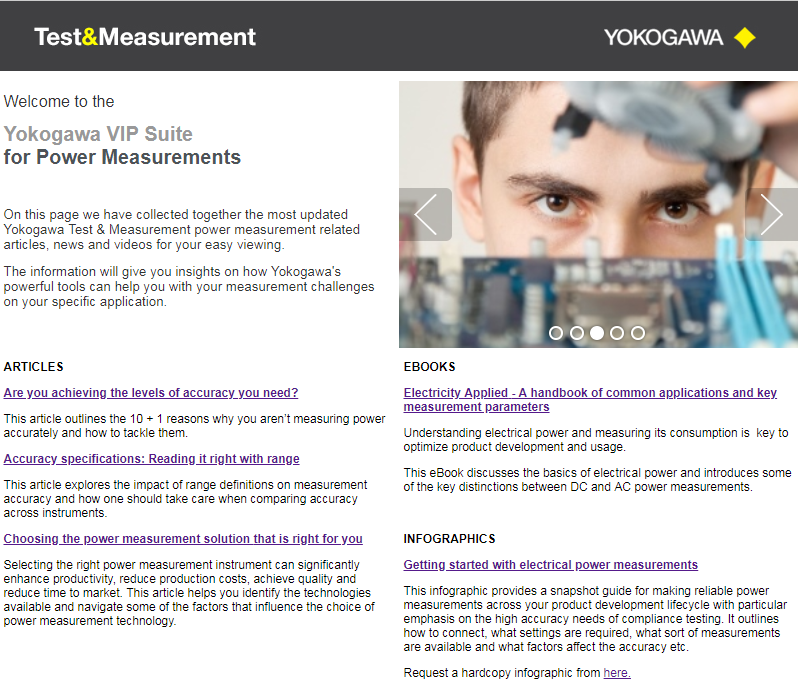Accelerate the Design, Validation, and Testing of Motors and Drives
When you use Yokogawa instruments, you’re partnering with the leader in power analysis. This means spending less time on second-guessing the quality of your measurements and focusing more on moving your project forward. Yokogawa provides tools to help you analyze the “electro” and “mechanical” challenges of electromechanical systems. Gain valuable insight into the full source-to-load system from the supplied power to motor output - and everything in between.

A 4-Step Process for Testing Motor & Drives Systems
White Paper
Electric motors are electromechanical machines that convert electric energy into mechanical energy. Despite differences in size and type, all electric motors work in much the same way: an electric current flowing through a wire coil in a magnetic field creates a force that rotates the coil, thus creating torque. Understanding power generation, power loss, and the different types of power measured can be intimidating. This white paper gives an overview of basic electric and mechanical power measurements and the interfacing of drives in motors.
Read the White Paper

Tools for the Development of Premium Efficiency Motors
White Paper
Standards driving energy efficiency classifications are a driving force behind the development of the next generation of motor and drive technologies. These classifications drive manufacturers to maximize efficiency, requiring a high confidence in energy measurements.
Read the White Paper

eBook
Electrical Motor Power Measurement & Analysis
Understanding motor power consumption and measuring efficiency is key to optimizing motor development and usage. This eBook discusses the basics of power measurements of motor systems, including the drive system, while also looking at mechanical measurements.
Download eBook
Webinar
Motors & Drives Analysis
Motors & Drives Analysis will provide attendees with education and measurement solutions for making precision high-accuracy power measurements on an electric motor system via industrial motor drive applications.
View Webinar
Case Study
Kuka Case Study
KUKA is one of the world’s leading specialists in automation providing complete turnkey solutions for customer-specific automation requirements.
Download Case Study
The Measurement Challenge
Various measurements at tests points on the motor and drive system require specialized equipment optimized to ensure the highest quality with few trade-offs. The correct instrument may depend on the level of accuracy, number of channels, or type of signal being acquired.

In this application note you will learn when and how to use different methods to connect a current transformer to a power analyzer.
With the increased demand in electric-hybrid vehicles, the electromechanical designs of in-vehicle systems are becoming more sophisticated and there has been a demand shift towards high efficiency brushless direct current motor (BLDC) implementation. Think of motorized seat adjustment, electric window, power steering, HVAC fans, pumps, etc. In many of these systems various types of motors are used as actuators; more specifically, 3-phase BLDC motors are gaining popularity as they provide these important advantages:
- Improved speed vs torque characteristics
- High dynamic response
- High efficiency
- Extended speed ranges
- Long operation life
How can I capture data from motion sensors synchronized with other analog data? The Yokogawa ScopeCorder series of instruments feature input modules and functions to make this possible.
Use built-in calculations to analyze motor rotor position of Brushless DC motors (BLDC) and Permanent Magnet Synchronous Machines (PMSM) and find the relative angle between the rotor and position sensors such as encoders or resolvers
- How to Measure Harmonics with WT3000E Harmonic Measurement Meter
- Harmonics standards compliance
- Measuring up to 50 orders of harmonics at 1 KHz
- 4 input elements
- Measuring phase angles between phases
Standards driving energy efficiency classifications are a driving force behind the development of the next generation of motor and drive technologies. Learn more here.
Government agencies that define the standardization of energy efficiency metrics continue to be a driving force behind the development of the next generation electric vehicle powertrains. These metrics require manufacturers to have high confidence in their measurements and motivate the optimization of efficiency.
Automotive Manufacturing – Measuring for efficiency
Two key criteria for successful development and mainstream adoption of (hybrid) electric vehicles are - reliability and driving range. The lower the loss in electric systems, the longer their lifetime and the more efficient the drivetrain, the longer the driving range. But as powertrains, charging systems, infotainment and safety systems grow more sophisticated in the ear of the connected car, hybrid and electric vehicle development requires mechatronic analyses of unprecedented certainty and flexibility.
Are you achieving the levels of accuracy you need?
This article outlines the top reasons for inaccuracies in power measurements and how to tackle them.
Download the article to learn about:
- Validity of instrument specifications
- External sensors and temperature effects
- Calibrating a measurement set up
Energy efficiency directives from bodies like International Electro technical Commission (IEC), European commission, California Energy Commission (CEC) and others govern standards across various classes of electrical, electronic and mechatronic equipment.
This infographic provides a snapshot guide for making reliable power measurements across your product development lifecycle with particular emphasis on the high accuracy needs of compliance testing.
More than a test tool
Typically, a portable scope or test tool is used by an engineer to diagnose faults on a production line in real-time, or to carry out tests in a workshop. But how can faults be detected and diagnosed when they are intermittent and the engineer needs to be somewhere else? On the other hand, a portable data logger can capture lots of data, including the faults over a period of time, but requires the data to be searched and analysed later to make sense of it.
The WTViewerE is a powerful software that supports remote analysis and control of multichannel measurements from the WT series of Yokogawa power analyzers. In addition to real-time control of remote measurements in multiple formats and customizable layouts, the latest version of the software allows any 4 Yokogawa power analyzers regardless of configuration to be synchronized for multi-unit measurements. This allows for sophisticated computations for larger applications that may need more than one power analyzer.
In this customer case story, Reiner Schultheiss; electrical engineer at Michelin tire manufacturing, reflects on his time with the company and explains how the portable Yokogawa DL350 ScopeCorder was welcomed to Michelin and how it ensures quality at the tire manufacturing process. In this customer case story, Reiner Schultheiss; electrical engineer at Michelin tire manufacturing, reflects on his time with the company and explains how the portable Yokogawa DL350 ScopeCorder was welcomed to Michelin and how it ensures quality at the tire manufacturing process.
As a one of the largest motorcycle manufacturers, Triumph confirms every bike is precision-engineered to deliver a complete riding experience. To ensure higher performance and efficiency of the motorcycle powertrain, Triumph test their engines under rigorous conditions, measuring and analyzing a vast array of parameters under varying conditions, from sensors configured and positioned all around a bike.
As a respected pioneer in folding bikes, Brompton’s first foldable e-bikes was eagerly anticipated. However, to develop such high-performance e-bikes engineers at Brompton needed to perform comprehensive dynamic testing to achieve rider – bike harmony.
Understanding motor power consumption and measuring efficiency is key to optimizing motor development and usage. This eBook discusses the basics of power measurements of motor systems, including the drive system, while also looking at mechanical measurements.
Understanding motor power consumption & measuring efficiency is key for motor development. Learn the basics of power measurements of motor systems (drive systems) & review mechanical measurements.
Product Overviews
The current sensor element for the Yokogawa Test&Measurement WT5000 Precision Power Analyzer is ideal for applications requiring a current transformer for high-current measurements. The internal DC power supply simplifies preparations before measurement, requiring only a connecting cable and eliminating the external power supply.
The WT5000, an industry-leading power analyzer, features seven field-removeable elements, 10 MS/s, 1 MHz power bandwidth, 18-bit resolution, and 0.03% basic power accuracy. Yokogawa Test&Measurement continues to innovate on the platform, enabling /D7 data streaming, /G7 harmonics, and flicker analysis.
The new current sensor element replaces the traditional current inputs and includes a sensor input terminal with integrated ±15V power supply, eliminating the need for an external power supply. The isolated voltage terminals remain the same as the 5A and 30A elements.
Test and measurement engineering work groups can have differing priorities and requirements, which often results in multiple instrumentation systems and data file formats, as well as incompatible reporting. This lack of effective communication between groups and instruments causes decreased efficiency and quality and increased spending and time to market. Unify test and measurement instrumentation, software, and data across engineering teams with a suite of solutions that caters to the different needs of engineering work groups, including accurate power data, fast sampling rates, long recordings of multiple different input types, and insights into waveform data.
How-tos
Having multiple memory options allows engineering groups to optimize how data is stored, no matter if you need to record for a long time at slower sampling rates, do a fast capture at high sampling rates, or anything in between.
The Yokogawa Test&Measurement DL950 ScopeCorder operates as an oscilloscope and incorporates the ability to record data for long periods of time like a data acquisition recorder. There are four memory types on the DL950 ScopeCorder: internal memory, solid state drive, flash memory, and PC storage through the IS8000 Integrated Test and Measurement Software Platform. This videos talks about the advantages of each of these and how to pick the best data recording method for you.
Webinars
- Multi-phase measurements
- Measurement techniques
- Measurement applications
- Real-world examples and more
While DC power measurements are relatively straight forward, AC power measurements that include distorted waveforms, varying power factors, and multiple phases can add complexity to an otherwise simple measurement. During this webinar, we cover multiple fundamentals of power measurement.
Key topics include:







































